September, 2021 Educational Site established of our Climate Change Initiative for Zero Carbon Electric Grids

15 June, 2021 VoluMetrix's NIVA|HF for Heart Failure Patients Designated as Breakthrough Device by U.S. FDA


June, 2021 GeoSierra's Abstract accepted for ALTA 2021 Conference on In-Situ Gold Recovery
The paper's title is 'In-Situ Gold Recovery from Deep Palaeochannels via Multi-Azimuth Highly Permeable Vertical Inclusions'.

May, 2021 In-Situ Recovery of Gold from Deep Palaeochannels
GeoSierra's multi-azimuth self propagating fluidized inclusion technology is ready for field deployment trials of the in-situ recovery of gold from deep palaeochannels. Once mineral recovery is completed, the wells are converted into a palaeo-channel water storage scheme.
A multi-azimuth casing system is installed and cemented in place by a conventional drill rig. Expansion of the casing initiates a vertical fluidized plane on azimuth, which self propagates as a fluidized inclusion on azimuth using a non-invasive highly viscous food grade starch carrying a highly permeable sand proppant. The injection process is not a fracturing mechanism, and is not applicable to hard brittle rock, instead it creates a self-propagating fluidized inclusion propagating on azimuth in anelastic weakly cemented formations. The food grade starch degrades into drinking water quality end products, such as sugars and water.View the Video on how we construct subsurface Permeable Reactive Barriers and the ERM/GeoSierra Environmental video on the installation and QA/QC monitoring of the Concord, CA PRB, or view the video that Savannah River National Laboratory produced of GeoSierra Environmental installed PRB at SRNL.
The lixiviant selected for in-situ gold recovery is compatible with the palaeo-channel waters, and meets drinking water standards following gold recovery. Enhancement of the lixiviant selected for in-situ recovery is optimized by pH, Eh and ion exchange control using an above ground electrochemical cell. The hexagon in-situ treatment zone is hydraulically contained within the vertical multi-azimuth highly permeable inclusions. The hydraulic containment is maintained by a balance of fluid injection and withdrawal, with the extremely high permeable sand propped vertical inclusions ensuring hydraulic containment. Gold is recovered from the above ground treatment system by ion exchange resins. After the gold is recovered, the wells are converted into a palaeo-channel water storage scheme.
In-Situ Extraction of PFAS Compounds from Groundwater
GeoSierra's multi-azimuth self propagating fluidized inclusion technology is ready for field deployment trials of the in-situ extraction and in-well concentration of PFAS compounds from groundwater utilizing multi-azimuth highly permeable vertical planes and foam fractionation.
Globally, there are hundreds of sites that have significant risks posed by PFASs to human health and the environment. The major challenges associated with PFASs is their relatively high mobility, extreme persistence in the subsurface, their potential for bioaccumulation, and their significant toxicological impacts to human health and the environment at extremely low concentrations (ppt). To date, there are limited in-situ remediation options for PFAS impacted sites, with absorption onto GAC or polymers for groundwater plume control being the only proven in-situ method, but due to the high volumes of groundwater and low absorption of PFASs to these absorption materials, such absorption technologies are not a cost-effective or long-term remedial solution.
In-situ injection of nitrogen into the lower portion of highly permeable multi-azimuth vertical planes, enables the extraction of PFAS compounds from the groundwater by foaming to the top of the multi-azimuth highly permeable planes, vacuum collection to a collector, and then generate an in-well hyper-concentrate PFAS for extraction and destruction. The in-situ treatment zone is hydraulically contained within the vertical multi- azimuth highly permeable inclusions. The vertical permeable inclusions contain 85% of 12/20 sand proppant and 15% of 20/40 sand proppant for an in-situ permeability of ~2,600Darcies at 50m depth. The nitrogen bubble size decreases with flow path in the highly permeable planes, resulting in the rapid removal of PFAS compounds from the groundwater. For any PFAS extraction enquiries contact Deborah Schnell.
Berkshire Hathaway Energy (BHE) Flash Geothermal Plants, Imperial Valley, CA
BHE owns and operates ten (10) flash geothermal plants producing 345MWe on a continuous basis, i.e. 24/7 in the Salton Sea area of southern California. The geothermal fluids contain significant quantities of carbon dioxide, and being a non-condensing gas, when the geothermal fluids are flashed to steam the non-condensing gases are separated, containing 99.9% carbon dioxide and are released to the atmosphere. These geothermal plants are comparable to coal fired electric generation plants as regards carbon emissions. These geothermal plants release ~3million tonnes of carbon dioxide to the atmosphere per year. GeoSierra approached BHE Renewables four (4) years ago in an attempt to capture the carbon dioxide separated during the flashing of the geothermal fluids, and cyclically store the carbon dioxide in both shallow and deep reservoirs as a carbon energy storage (CES) scheme. Benefits of such a scheme are that carbon emissions are zero and the CES scheme can provide on demand high revenue peak electrical energy. BHE Renewables were not interested at that time on such a proposal, and continue to be a significant carbon emitter comparable or worst than conventional coal fired electrical generation plants.
December 15, 2020 United Downs GeoThermal, Cornwall, UK - Induced Seismicity
The United Downs Geothermal project is a deep dry hot rock geothermal electrical generation (4MWe) project. The injector and producer wells have been drilled into a fault at depths of 4,500m and 2,500m, respectively. The prime reason why hot dry rock geothermal has not been successful, even with fifty (50) years of research, is the inability to successfully hydraulic connect the injector and producer, see GeoThermal. The induced seismicity due to the current well flow tests, see below, is an ominous sign of significant future induced seismic events. The well flow testing is presumeably trying to enhance the hydraulic connection between the injector and producer. Such a project should be under the supervision of a government agency with induced seismicity technical expertise, and not solely left to the local council.
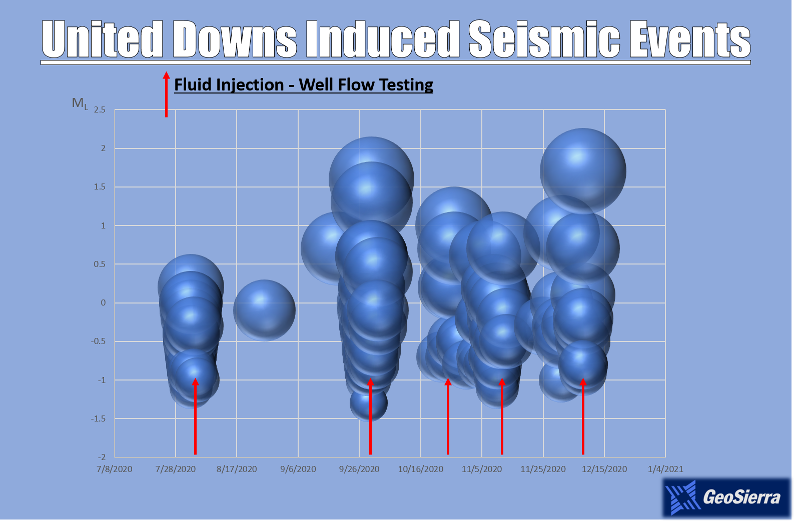
November, 2020 Newdigate, Surrey, UK Earthquakes Induced by Overpressure Removal at Horse Hill with Zero Petroleum Production
GeoSierra postulated in Sept 2019 that hydrocarbon fluids are being generated and have been over centuries, at or near the current epicenters of the seismic events. Fluid over-pressure from their generation open the hyper-stress sensitive calcite "beef" planes leading to hydrocarbon fluid migration some 3 kms to the reservoirs at HH-1. Such a scenario has been in equilibrium over centuries, with no or minimal induced seismic activity. For this scenario to occur, slight fluid over-pressure must be present at HH-1 and in its surrounding reservoirs.
It has been brought to GeoSierra's attention that UKOG have stated explicitedly in writing that they bled off wellhead overpressures as part of pre-rig arrival activities in late March, 2018 and late June, 2018. The overpressures involved a "few tens of psi". If the fluid overpressure at HH-1 is removed, by bleeding off excess pressure at the wellhead, the calcite planes close, hydrocarbon fluids can’t migrate from the source area, thus raising fluid over-pressures in the source area. These excessive fluid overpressures, 3kms from HH-1, give rise to the significant induced seismicity.
The calcite 'beef' planes were encountered in the Collendean Farm CF-1 well in 1964 and are clearly described in the well logs. These calcite planes were formed by natural hydraulic fracturing due to excessive fluid overpressures from nearby hydrocarbon generation. These planes extend for kilometers from the deep hydrocarbon source area to shallower reservoirs, and have acted as fluid conduits to relieve excess fluid pressures in the source area over geological time. The presence of the calcite 'beef' planes and fluid overpressures are sure warning signs of the potential hazards of induced seismicity from fluid extraction in such a fragile fluid pressure sensitive subsurface environment.
The timing of seismic events and the activities at HH-1 well are too compellingly time correlated, that a meaningful scenario linking the two should have been explored before now. The conclusions from the OGA workshop, October 2018, chaired by the BGS, cite that no casual link between the two could be conceived, and thus concluded that the seismicity was of natural causes. How the seismicity can be labelled as natural, just because a viable scenario linking the two can’t be formulated, is not considered a viable scientific approach to the issue. Hicks et al., 2019 also could not conceive of a viable scenario, and therefore concluded that the seismic events could only be of natural causes.
Let's just look at the issue from a probability point of view. The area is seismically inactive. The surrounding area hasn't experienced such an earthquake event over past centuries. So let's first assume the process is completely random, and that the seismic events are independent of the actions at HH-1. The probability of having an earthquake of ML~3 one day after bleeding off fluid overpressure in HH-1 on 31st March 2018 is extremely low, let's say 1 in a million. Three months later on 26th June, the fluid overpressure in HH-1 is bled off again and a similar earthquake occurs one day later. The joint probability of both events is now 1 in a million squared. Then by releasing and extracting the Portland bridge plug on the 4th July, i.e. again reducing the fluid overpressure in HH-1, and one day later a similar earthquake occurs, then the joint probability is now 1 in a million cubed, i.e. an infinitesimally small probability. The fact that the three occurrences did occur, i.e. the same action triggered a similar seismic event, means that there is an extremely high likelihood that the HH-1 actions and the seismic events are correlated.
Having established a realistic geological scenario linking the overpressure reductions at Horse Hill with the seismic events, and the extremely high likelihood that the actions and events are correlated, then we can say with virtually total confidence that the activities at Horse Hill have induced the seismic events over almost the past 3 years, from April, 2018 to date. The intensity of these induced seismic events have been as high as V, defined as strong, being felt by most people indoors and outdoors, strong shaking and rocking is felt throughout buildings, hanging objects swing violently, unstable objects may fall or overturn, liquids spill from filled open containers, and vehicles rock noticeably
Isn't it about time that the OGA and BGS revisit the link between Horse Hill activities of bleeding off wellhead overpressures prior to any subsurface activities as a direct cause of the induced seismic events at Newdigate?
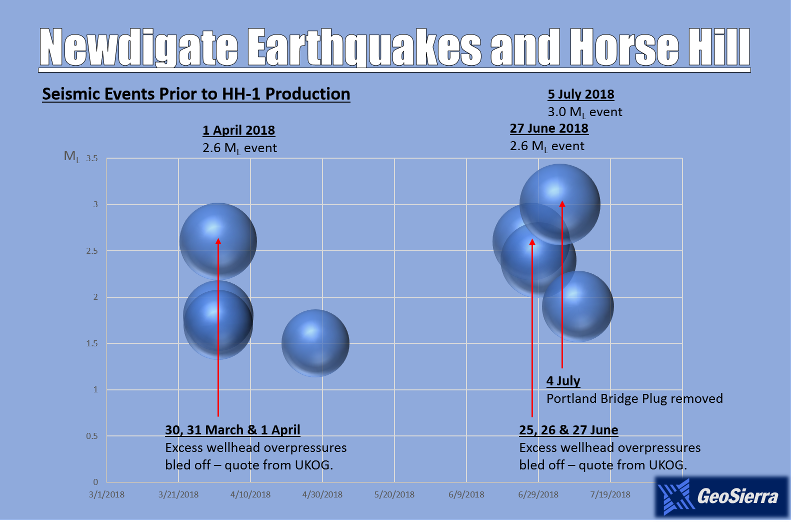
June 15, 2020 Savannah River Site, S.C. Video of Deep Iron Permeable Reactive Barrier Installation
Savannah River Nuclear Solutions have produced a video of the recent project completed by the team of GeoSierra Environmental and Cascade Drilling (Aiken SC office). The project entailed the installation of a Permeable Reactive Barrier (PRB) using the patented GeoSierra methodology of a Trenchless installation using expansion casings aligned along a single azimuth for injection of re-cycled zero valent iron (ZVI), creating a vertical panel of ZVI that intercepts an existing trichloroethene (TCE) plume. The project was completed at the Savannah River Site for the US Department of Energy. Any PRB enquiries contact Deborah Schnell. The iron PRB is constructed and monitored in real time by GeoSierra’s trenchless PRB installation method. To see how we construct these deep trenchless PRBs, view GeoSierra's PRB video.
February 24, 2020 Altcar Moss, Lancashire, UK - Aurora Energy Resources Ltd
GeoSierra submitted a comment to LCC (Lancashire County Council) today on the above application (LCC/2019/0037) with LCC referencing GeoSierra's comment as ENV177490548. GeoSierra's comment was as follows:
"The application does not detail how Aurora plan to overcome the hydraulic fracture height containment issue due to the presence of slickenside bedding planes in the Bowland-Hodder shales, and the associated excessive risks of significant induced seismicity. No service company, Schlumberger or Halliburton, has the hydraulic fracturing technology to overcome this issue. Please provide the name and qualifications of Jacob's hydraulic fracturing expert that reviewed the application for the Council."
The UK OGA (Oil & Gas Authority) and their consultants have zero hydraulic fracturing expertise. If they had even an elementary understanding of hydraulic fracturing, they would have immediately shut down Cuadrilla's Preston New Road PNR-2 hydraulic fracturing activities upon seeing the mini-frac data of August 13, 2019, two (2) days before Cuadrilla's start of fracturing operations. The mini-frac data from PNR-2 was inadvertently released to the public in September 2019, and was published online by DrillorDrop.
VoluMetrix Update
A recent paper on VoluMetrix's fast track NIH wearable for HF (Heart Failure) patients released from hospital is online at JCardiacFailure. The wearable device will enable the patient, at home, to monitor their excess fluid retention, thus significantly reducing hospital re-admission rates. Mayo Clinic is conducting the fifty (50) patient trial. Our founder is part owner and a full time researcher at VoluMetrix, specializing in venous and arterial waveform analysis to quantify vascular tone, hypertension, hypovolemia, stroke volume and heart valve performance. VoluMetrix are the licensee or assignee of patents and patents pending for their bio-medical devices. Grant's son Kyle is CEO of Volumetrix.
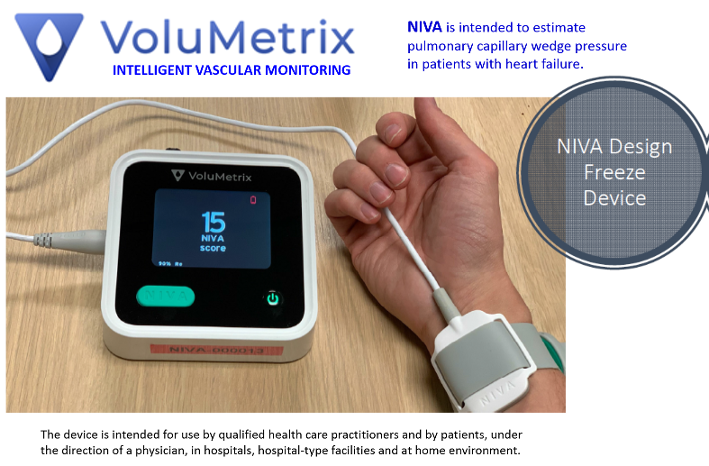
February 1, 2020 During the past two months, rainfall in the Minas Gerais state of Brazil has been significantly greater than 2019, when the Brumadinho Tailings Dam collapsed. Is another tailings dam collapse imminent?

September 2019 Oil & Gas Authority Oversight of Preston New Road Hydraulic Fracturing Operations
From a Freedom of Information (FOI) Request, it has been disclosed that the numerous warnings by GeoSierra on the Cuadrilla hydraulic fracturing operations at Preston New Road, when unheeded. The OGA solely solicited the views of Cuadrilla on these warnings, and never followed up with GeoSierra, or solicit the views of any technical expert. Cuadrilla dismissed GeoSierra's warnings as "flawed", without any technical explanation, and the OGA simply ignored GeoSierra's warnings.
If, the OGA had read GeoSierra's Preese Hall review, then they would have realized that the last person to have reasonable calculated BHPs (Bottom Hole Pressures) was Cuadrilla and their consultants. All of the calculated BHPs presented by Cuadrilla and their consultants for the Preese Hall well were incorrect and inconsistent. As of late 2014, Cuadrilla was misrepresenting measured WHPs (Wellhead Pressures) as calculated BHPs. These errors in Cuadrilla's calculated BHPs, required GeoSierra to recalculate BHPs, using their inhouse slick water fluid simulator, from Preese Hall well measured WHPs and flowrates. Our conclusion from the Preese Hall review still stands, i.e. it is impossible to fracture enhance the Bowland-Hodder shales with current hydraulic fracturing technology.
Newdigate, Surrey, UK Earthquakes and a plausible link to Horse Hill petroleum activities
GeoSierra has prepared a brief summary, that postulates a probable scenario of a direct link of the seismicity at Newdigate, Surrey, UK with activities and petroleum production at the Horse Hill well, HH-1. The timing of seismic events and the activities at HH-1 well are too compellingly time correlated, that a meaningful scenario linking the two should have been explored before now. The conclusions from the OGA workshop, October 2018, chaired by the BGS, cite that no casual link between the two could be conceived, and thus concluded that the seismicity was of natural causes. How the seismicity can be labelled as natural, just because a viable scenario linking the two can’t be formulated, is not considered a scientific approach to the issue.
It is postulated that hydrocarbon fluids are being generated and have been over centuries, at or near the current epicenters of the seismic events. Fluid over-pressure from their generation open the hyper-stress sensitive bedding planes leading to hydrocarbon fluid migration some 3 kms to the reservoirs at HH-1. Such a scenario has been in equilibrium over centuries, with no or minimal induced seismic activity. For this scenario to occur, slight fluid over-pressure must be present at HH-1 and in its surrounding reservoirs.
If the fluid over-pressure at HH-1 is removed, by bleeding off excess pressure at the wellhead or by production, the bedding planes close, hydrocarbon fluids can’t migrate from the source area, thus raising fluid over-pressures in the source area. These excessive fluid over- pressures, 3kms from HH-1, give rise to the significant induced seismicity.
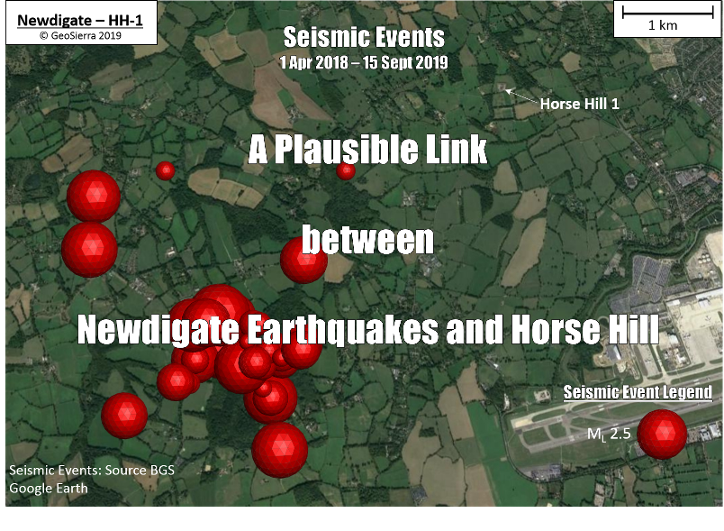
VoluMetrix have progressed will past the prototype stage in their National Institute of Health (NIH) fast track program, to develop and obtain FDA approval for a new wearable device for heart failure patients following hospital release. The wearable device will enable the patient, at home, to monitor their excess fluid retention, thus significantly reducing hospital re-admission rates. Mayo Clinic is conducting the fifty (50) patient trial. Our founder is part owner and a full time researcher at VoluMetrix, specializing in venous and arterial waveform analysis to quantify vascular tone, hypertension, hypovolemia, stroke volume and heart valve performance. Grant's son Kyle is CEO of Volumetrix.
Savannah River Site, S.C. Deep Iron Permeable Reactive Barrier
GeoSierra Environmental, Inc. are installing a 135’ deep iron Permeable Reactive Barrier (PRB) at the Savannah River Site, SC, to treat chlorinated contaminated groundwater. The PRB is constructed by the injection of 760 tons of recycled iron, and will be completed by November, 2019. The iron PRB is constructed and monitored in real time by GeoSierra’s trenchless PRB installation method. To see how we construct these deep trenchless PRBs, view our video. Any PRB enquiries contact Deborah Schnell.

Preston New Road, Lancashire, UK
The hydraulic fracturing induced events at Preston New Road from the 15 to 29 August 2019 are shown below. Rather than hydraulic fracture the shale formation, Cuadrilla have opened near horizontal bedding planes creating a heightened risk of induced seismicity, as the frac fluids have migrated ~750m, towards the east, updip on these hyper-stress sensitive slicken-sided bedding planes.
GeoSierra has made a short video on why the Bowland-Hodder shales at Preston New Road can’t be commercially enhanced by current hydraulic fracturing technology. The presence of extensive slickenside bedding planes, makes it impossible to frac enhance these shales by current technology. Hopefully, the video will better articulate this issue, that the numerous written communiques over the past year or more, have failed to do. Or click the image below to see the video.
With OGA approval, Cuadrilla have injected fluids into the sub-surface at BHPs far exceeding the overburden pressure, leading to a significant heightened risk of induced seismicity. Such induced seismicity is significant, >>1.0 ML, and far greater than what should be allowed in populated areas. So who are the responsible parties leading to this heightened risk of induced seismicity, which could have been easily avoided. GeoSierra has been warning the UK Oil & Gas Authority for more than a year of the risks of heightened seismicity at Preston New Road by excessive injection pressure. These persistent warnings were futile, as no action was taken in 2018 and nor in 2019. A short video that ponders the question:- "Who are the Responsible Parties?", and descibes GeoSierra's futile efforts to convince the OGA of the excessive risks due to high injection pressures.

August 2019 Induced Seismic Events of 2019 and 2018 at Preston New Road, Lancashire, UK
The hydraulic fracturing induced events in 2019 as of August 22, 2019 05:10:01 (UTC) are shown below. Rather than hydraulic fracture the shale formation, Cuadrilla have opened near horizontal bedding planes creating a heightened risk of induced seismicity, as the frac fluids have migrated ~750m updip on these hyper-stress sensitive slicken-sided bedding planes. The events induced from injection on the 23 August 2019, the 2.1 ML and the 2.9 ML had very similar epicenters as the 1.6 ML event shown below. The induced seismicity being 750m from the injection point should be raising alarm bells at the UK regulatory agencies.
A 2.1 ML induced event on 24 August at 22:01:35 (UTC). A 2.9 ML induced event on 26 August at 07:30:47 (UTC).
Finally the UK regulatory agencies have acted. As of 26 August 2019, OGA state that hydraulic fracturing operations at Preston New Road have been suspended.
In a series of emails, 13 to 22 August 2019, GeoSierra had requested from Cuadrilla the names of the Schlumberger persons responsible for the frac fluid pumping schedule design for the PNR-2 hydraulic fracturing operations. Cuadrilla responded that they, Cuadrilla, do all the frac fluid pumping schedule design inhouse, and that Schlumberger are a service provider that execute on Cuadrilla's instruction and design.
Cuadrilla contacted GeoSierra on the 23rd August 2019, and mentioned that on the 21st August 2019 they were injecting in either sleeve 5 or 6, i.e. close to the toe of the well. GeoSierra stated that they were being proactive in warning Cuadrilla of the induced seismicity risks associated with excessive BHPs, and the consequences of opening the slicken-sided bedding planes. Cuadrilla stated that the TLS was excessively restrictive hindering their ability to hydraulic fracture the well. GeoSierra replied that even if it was doubled, being a log scale, i.e. to 0.8 ML, it would not have changed the outcomes. From the discussions, it was apparent that Cuardilla do not have a plan on how to tackle the slicken-sided bedding planes.

The hydraulic fracturing induced events in 2018 are shown below. The largest seismic event in both cases is at the same location, that further confirms GeoSierra's concerns and issues raised below. Rather than hydraulic fracture the shale formation, Cuadrilla have opened near horizontal bedding planes creating a heightened risk of induced seismicity, as the frac fluids can migrate significant distances on these hyper-stress sensitive bedding planes.

Analysis of the induced trailing seismic events from hydraulic fracturing of 21 August 2019, are shown below, indicating that on the 22 August 2019, 15:23:34 (UTC), having the same epicenter, the frac fluids had migrated to a different depth, giving rise to the ML 1.0 event. Time is measured from the first major trailing event.

August 2019 Preston New Road, Lancashire, UK
GeoSierra's 2017 review of the Preese Hall 2011 well stimulations concluded that, due to the presence of extensive slickensided bedding planes, the Bowland-Hodder shales could not be commercially fracture enhanced by current hydraulic fracturing technology. The review was conducted in 2016, and posted online in early 2017, after GeoSierra had decided it didn't want to pursue UK onshore shale.
Fracturing operations began on the 15th August 2019 on the PNR-2 well. Review of earlier operations on PNR-1Z and Preese Hall well stimulations, indicate a high risk of induced seismicity with minimal gas production enhancement - see PNR-1Z Review.The stimulations of the stages of the PNR-1Z well, initially induced hydraulic near vertical fractures, whose height growth was terminated by the presence of slickensided bedding planes, which were encountered in the PNR-1 well, as reported by Clarke et al., 2019 (SPE-195563-MS). Subsequently, the Bottom Hole Pressures (BHPs) rose sufficiently to exceed the normal stress of the near horizontal bedding planes, opening these hyper-stress sensitive bedding planes and thus significantly increasing the risk of induced seismicity, without any or minimal gas production enhancement. This heightened risk of induced seismicity can be avoided by placing limits on BHPs during injection.
The lack of any tiltmeter monitoring in the HFP (Hydraulic Fracturing Plan) for PNR-2 is rather strange, as it was recommended to the UK agencies in 2018, as a prudent measure considering what occurred during the Preese Hall well stimulations. Tiltmeters would show conclusively whether the frac opening was vertical or near horizontal, whereas seismic monitoring can be misleading into where frac opening is occurring since it is in response to slip.
Shutin data analyses of the PNR-1Z well hydraulic fracturing stages show conclusively and unambiguously, that near horizontal bedding planes (dipping at ~20° to the west) were opened by the excessive hydraulic fracturing pressures, leading to a significant heightened risk of induced seismicity.
GeoSierra notified the relevant UK agencies, (Environment Agency, Oil & Gas Authority, and the British Geological Survey) and Cuadrilla of the above issues and the significance risks of induced seismicity in early August 2019, prior to the start of hydraulic fracturing of the PNR-2 well. As of the 22nd August 2019, GeoSierra has had no response from any of the UK responsible agencies or Cuadrilla concerning the significant risk of induced seismicity due to excessive BHPs occurring during the hydraulic fracturing operations at Preston New Road.
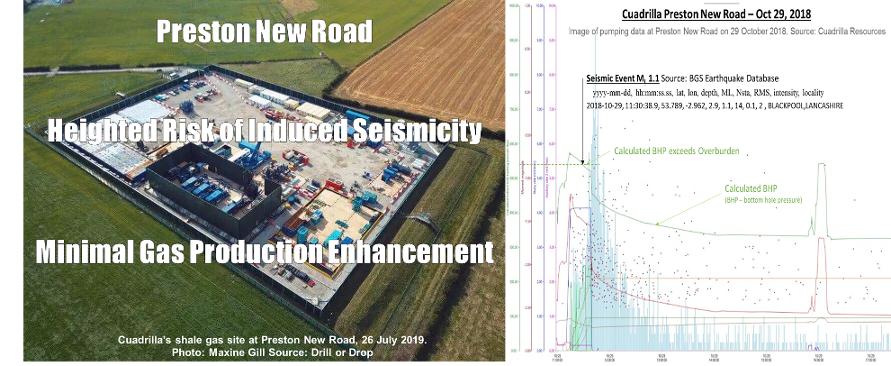
April 2019 Prior to the Brumadinho Tailings Dam collapse, rainfall was 3.6 times greater than the mean rainfall of the prior 10 years. February and March rainfall of this year were 3x the mean rainfall of the prior 10 years, see below figure. What preventative measures are being implemented to increase the stability and reduce the risk of collapse of existing unsafe tailings dams? News reporting doesn't mention any remedial actions being taken to increase the stability of existing unsafe tailings dams, especially those unsafe tailings dams located in the Minas Gerais state of Brazil.
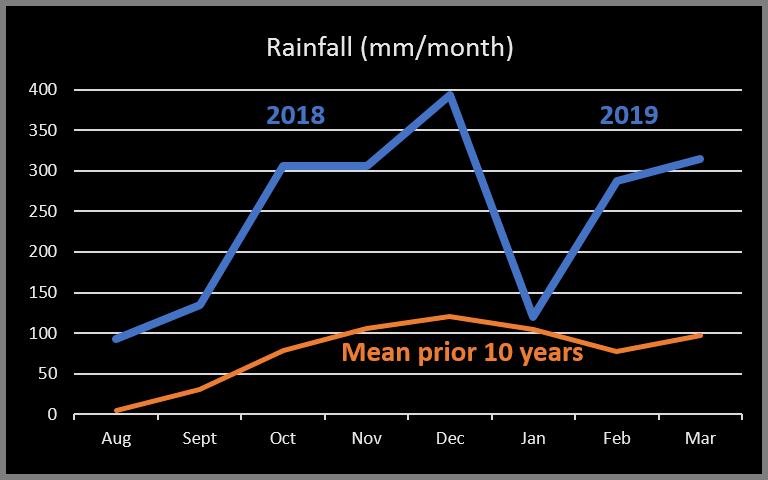
February 2019 In an analysis initiated by the recent Brumadinho Tailings Dam failure, GeoSierra discovered significant surface water ponding had occurred on the crest of the Brumadinho Tailings Dam just a month before it tragically failed. Upstream tailings dams, such as the Brumadinho tailings dam, are especially prone to failure due to an increase in the pore water pressure; such as caused by surface water ponding on the dam crest, by either dam instability or piping failure.
This ponding of surface water is the most likely cause of the Brumadinho tailings dam failure. Surface waters infiltrate into the dam over time, thus significantly raising the dam's pore water pressures, which reduce the tailings mean effective stress, until liquefaction is triggered. Once liquefaction is triggered, in this case it is called "Static Liquefaction", the failure process following the liquefaction triggering is extremely dynamic and leads to flow liquefaction, as earlier seen in the tragic Aberfan disaster of 1966, and numerous tailings dams failures over the years, and more recently the Fundao tailings dam collapse of 2015, and now this recent tragic flow liquefaction failure, with its significant loss of human life and environmental damage.
BBC News reporter: Ricardo Senra, article of 22 February 2019. “There was a spring above the dam, but the pipe was broken,” he says. “The water was falling directly on to the dam. So much so that the middle of the dam was no longer dry. This was more than a month ago.”
GeoSierra's electro-osmosis system, when activated by seismic or motion sensors, stabilizes such high risk structures; such as an upstream tailings dam, during an earthquake event and/or due to excessive pore water pressures.The electro-osmosis system can be powered continuously at low current to dewater and/or permeation grout the tailings, with automatic control to raise the current to stabilize the dam, due to sensed motion or excessive pore pressures. Following the dewatering/stabilization of the tailings by electro-osmosis, decommissioning work can begin. If the electro-osmosis stabilization system was not implemented prior to decommissioning, there are extremely high risks of tailings dam failure being initiated and induced by decommissioning activities
Brumadinho Tailings Dam
Rainfall over the past 5 months of 2018, was 3.6 times greater than the mean of the past 10 years.
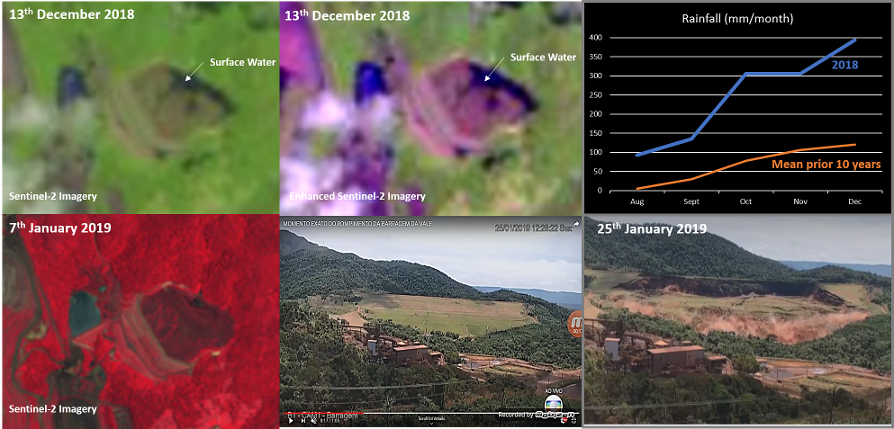
January 2019 GeoSierra Environmental, Inc. is finalizing the design report for a 200' deep iron PRB (Permeable Reactive Barrier) at the Savannah River Site, SC. Full scale construction will be begin later this year. Any PRB enquiries contact Deborah Schnell. The PRB construction at Norco, CA is almost complete.
Grant Hocking, GeoSierra's Founder and President, was co-inventor of four (4) patent applications in the past 18 months, relating to biomedical applications, waveform analysis and biomedical devices. This month, he has filed three (3) patent applications as the sole inventor, relating to hypertension, blood pressure, vascular blood vessel properties, ageing and exercise impact on hypertensive state, and biomedical devices to measure hypertensive state, vascular properties and vasodilation, and also measure blood pressure without a cuff. These technologies are being developed for commercial use by VoluMetrix, of whom Kyle Hocking (Grant's son) is CEO.
January 2018 GeoSierra Environmental, Inc. is mobilizing for the installation of an iron PRB (Permeable Reactive Barrier) for groundwater remediation in Norco, CA.The PRB is 300' long, to be constructed from 20' depth down to a total depth of 95' BGS along a busy city street. Any PRB enquiries contact Deborah Schnell. The PRB construction will be monitored in real time by GeoSierra's active resistivity imaging technology.
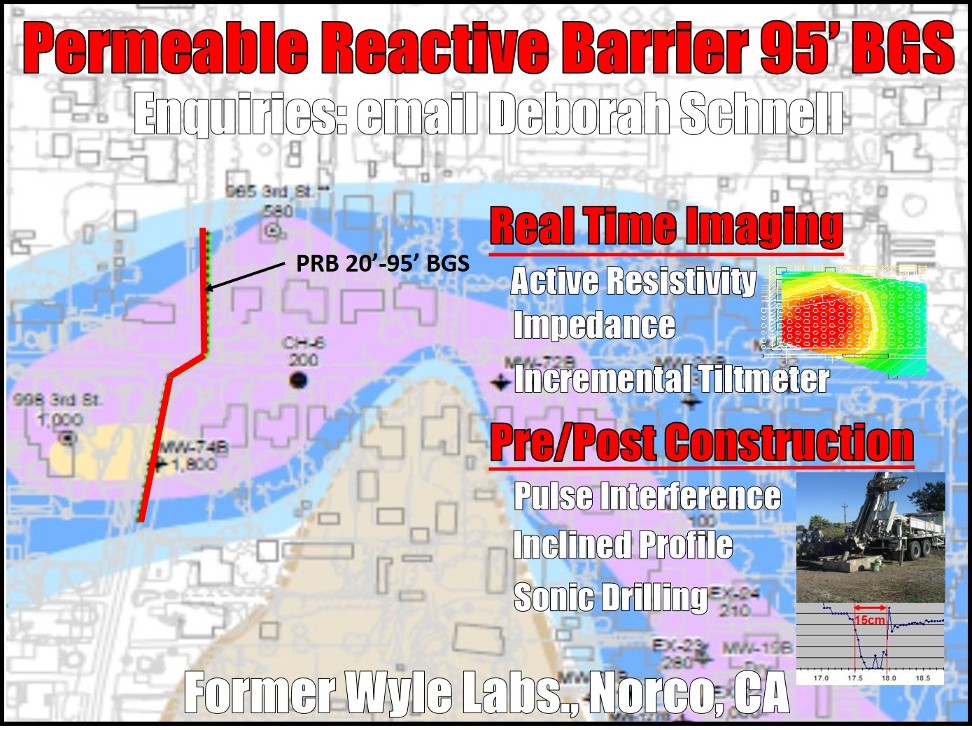
August 2017 - Funding for the Geothermal Energy trial cell has been approved, subject to the bench scale performance of the lithium enrichment cell, for the final design, land and lease acquisition for construction in the 4th qtr 2018 in the Salton Sea Geothermal Field, Imperial County, California. The trial cell will extract groundwater geothermal brines, store and cycle supercritical carbon dioxide in the sub-surface for electric power generation, and extract lithium from the geothermal brines. Revenue for the trial cell is from four streams: 1) carbon dioxide storage, 2) electric power generation, 3) minerals extracted from the groundwater brine, primarily Lithium, and 4) sale of desalinated groundwater.
The lithium enrichment cell uses alternating polarity electrodes constructed from calcined petroleum coke proppant as developed by Asbury Carbons in association with GeoSierra, for GeoSierra's ERG - electric resistive heating enhanced bitumen/heavy oil recovery process - see Electric EOR. The calcined coke proppant is coated with different compounds to produce the alternating polarity lithium and chloride ion selective electrodes, that extract the lithium ions from the geothermal brines and concentrates the lithium ions in a battery grade lithium concentrate solution.
Without significant lithium revenue, baseload geothermal electrical power generation in southern California is not an attractive investment, primarily due to the lack of a meaningful tax on carbon emissions, the regulated electrical pricing is tied to the current natural gas price, and the low revenue/MWhr for baseload electricity. Using supercritical carbon dioxide as the subsurface working fluid, a large portion of the baseload generation can be provided as on-demand peak generation capacity, thus significantly increasing the revenue/MWhr. The performance of the lithium enrichment cell and the siting of the field trial in high lithium groundwater are both crucial for a successful field trial of the lithium enrichment process.
GeoSierra Environmental, Inc. has been awarded a design/build contract for a 900' long, deep (96' bgs), iron PRB for groundwater remediation in a southern Californian city. The PRB is to be constructed along a busy residential street. Any PRB enquiries contact Deborah Schnell.

March 2017 - GeoSierra recently completed a review of the UK 2011 Preese Hall well stimulations. A copy of this review and recommended alternate stimulation methods are contained in this review report. GeoSierra presented to the Massachusetts Institute of Technology in January on the importance of anelasticity in petroleum geomechanics - view the abridged presentation.
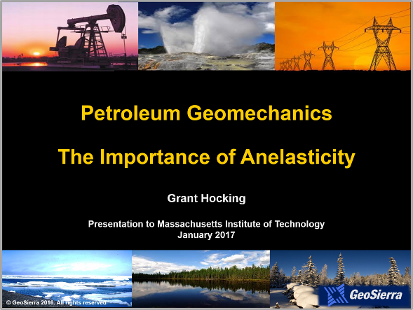
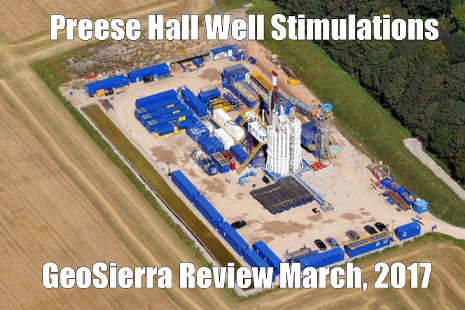
December 2016 GeoSierra Environmental Inc. completed the construction of 1,100' PRB at the former Scotia Navy Depot.
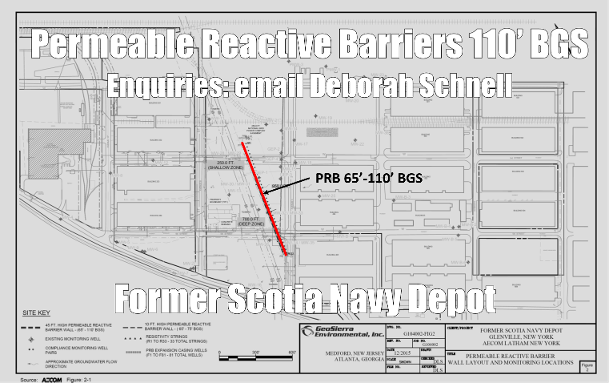
October 2016 GeoSierra is under contract to Massachusetts Institute of Technology (MIT) to assist MIT in a large multi- year research project on hydraulic fracturing, with specific emphasis into the interaction and propagation of hydraulic fractures with natural fractures and formation interfaces, funded by a major national oil company.
August 2016 Cascade Environmental Holdings LLC acquires GeoSierra Environmental Inc and Panther Technologies Inc to enhance their environmental capabilities and services - see announcement.
March 2016 GeoSierra's geothermal electrical power generation system in enhanced hot ductile low perm formations is in final feasibility assessment study for field pilot deployment mid-2017.
GeoSierra's carbon energy storage system in ductile turbidite reservoir legacy oil and gas fields is in final feasibility assessment study for field pilot deployment mid-2017.
GeoSierra Environmental Inc. is finalizing the design and mobilizing for the construction of a 1,000' long iron proppant Permeable Reactive Barrier at the former Scotia Navy Depot, Glenville, NY. The PRB is to be constructed to a total depth of 110', and it's injected geometry will be mapped in real-time by GeoSierra's active resistivity mapping technology. For enquiries into design/build services of PRBs in the USA contact Deborah Schnell at dschnell@geosierraenv.com.
March 2015 The planned in situ heavy oil recovery ERG field trial, using electric resistive heating with gravity drainage is on indefinite hold due to the low price of Kern River crude.
The stimulation of the light oil turbidite reservoirs in the Southern San Joaquin Valley using the Azi-Frac technology is postponed until the price of WTI stabilizes at $65/bbl or higher.
October 2014 GeoSierra Environmental Inc. recently completed an iron proppant PRB at a SuperFund site in Peterborough, New Hampshire for groundwater remediation. More than twenty (20) iron proppant PRBs have been installed in the USA by GeoSierra's trenchless technology.
GeoSierra's electrically conductive -8/+20 proppant and grahite electrodes are now ready for deployment in the EOR field trial of the ERG system, i.e. electrical resistive heating with gravity drainage. The first trial is planned to be conducted in a shallow heavy oil unconsolidated sand reservior in western USA.
GeoSierra's electrically conductive calcined petroleum coke proppant is available in three size distributions: coarse -8/+20, medium -20/+40 and fine -40 mesh.
GeoSierra's retrofit stimulation tool for stimulating deep existing wells in turbidite formations is not expected to be field deployable until mid-2015.







 +1 (770) 559-4429 info@geosierra.com
+1 (770) 559-4429 info@geosierra.com
